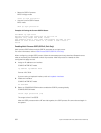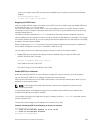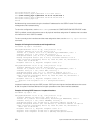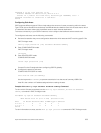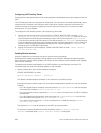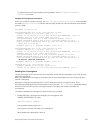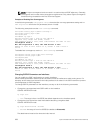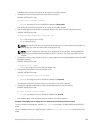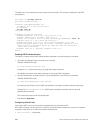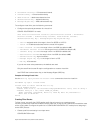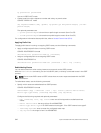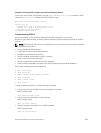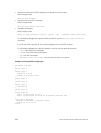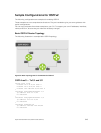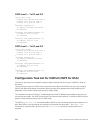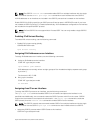
The bold lines in the example show the change on the interface. The change is reflected in the OSPF
configuration.
Dell(conf-if)#ip ospf cost 45
Dell(conf-if)#show config
!
interface TengigabitEthernet 0/0
ip address 10.1.2.100 255.255.255.0
no shutdown
ip ospf cost 45
Dell(conf-if)#end
Dell#show ip ospf 34 interface
TengigabitEthernet 0/0 is up, line protocol is up
Internet Address 10.1.2.100/24, Area 2.2.2.2
Process ID 34, Router ID 10.1.2.100, Network Type BROADCAST,
Cost: 45
Transmit Delay is 1 sec, State DR, Priority 1
Designated Router (ID) 10.1.2.100, Interface address 10.1.2.100
Backup Designated Router (ID) 10.1.2.100, Interface address 0.0.0.0
Timer intervals configured, Hello 10, Dead 40, Wait 40, Retransmit 5
Hello due in 00:00:06
Neighbor Count is 0, Adjacent neighbor count is 0
Dell#
Enabling OSPFv2 Authentication
To enable or change various OSPF authentication parameters, use the following commands.
• Set a clear text authentication scheme on the interface.
CONFIG-INTERFACE mode
ip ospf authentication-key key
Configure a key that is a text string no longer than eight characters.
All neighboring routers must share password to exchange OSPF information.
• Set the authentication change wait time in seconds between 0 and 300 for the interface.
CONFIG-INTERFACE mode
ip ospf auth-change-wait-time seconds
This setting is the amount of time OSPF has available to change its interface authentication type.
During the auth-change-wait-time, OSPF sends out packets with both the new and old
authentication schemes.
This transmission stops when the period ends.
The default is 0 seconds.
Configuring Virtual Links
Areas within OSPF must be connected to the backbone area (Area ID 0.0.0.0).
If an OSPF area does not have a direct connection to the backbone, at least one virtual link is required.
Configure virtual links on an ABR connected to the backbone.
• hello-interval — help packet
640
Open Shortest Path First (OSPFv2 and OSPFv3)



